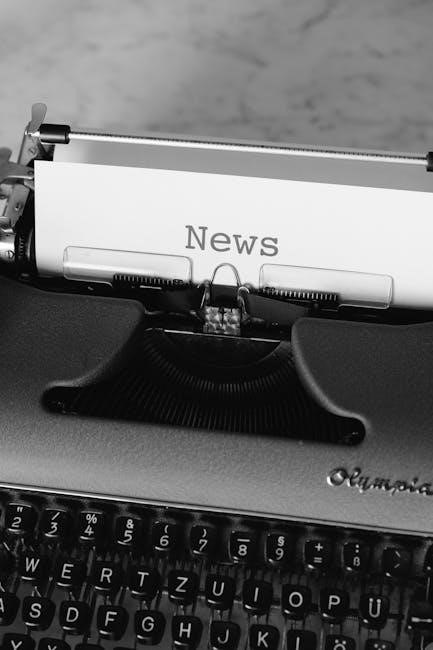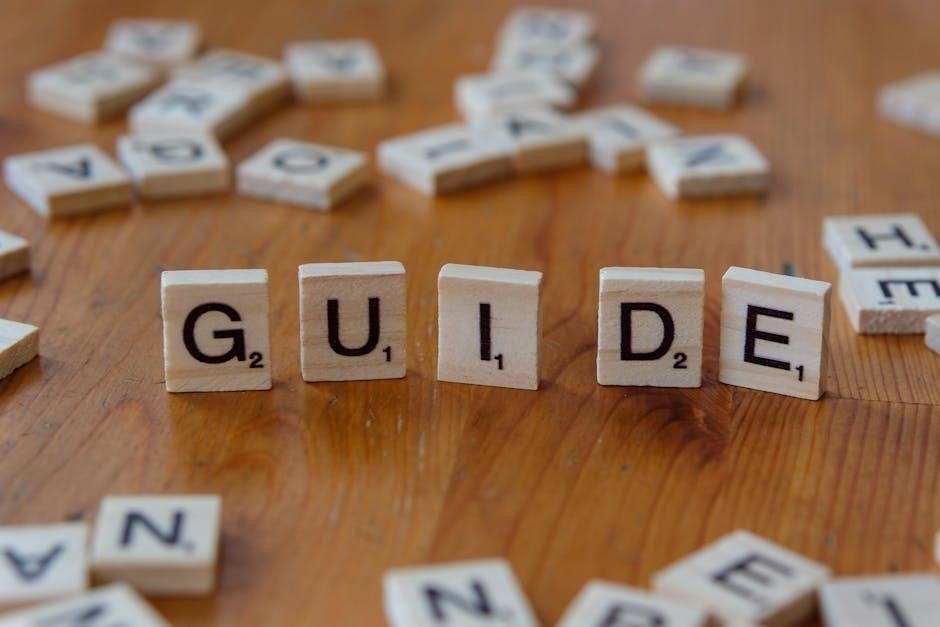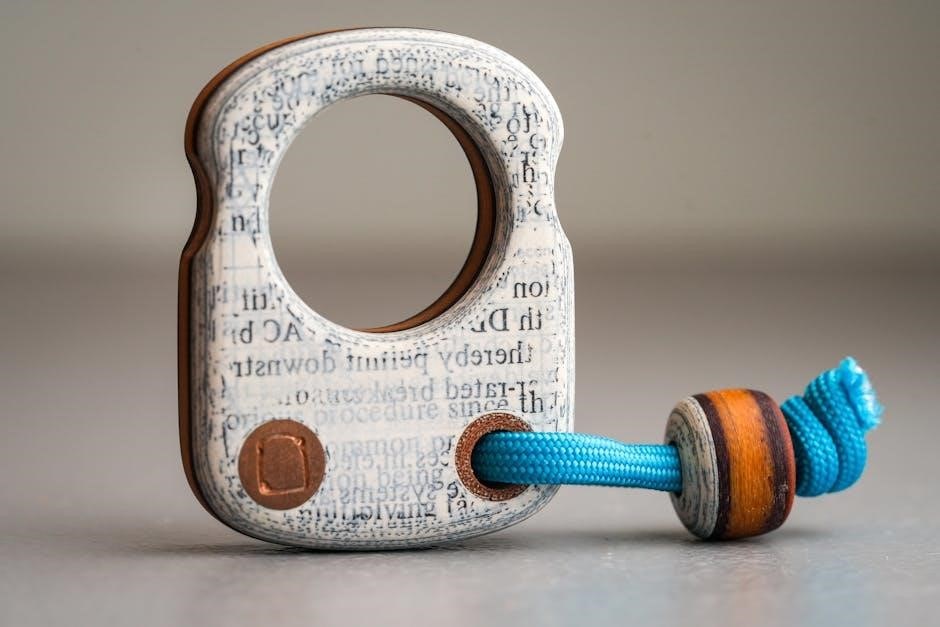Drafting lettering involves creating precise, consistent text for technical drawings and designs. Tools like the Ames and Wrico lettering guides help achieve accuracy and uniformity in letter formation.
1.1 What is Drafting Lettering?

Drafting lettering refers to the precise and standardized method of creating text in technical drawings, ensuring clarity and consistency. It involves using tools like the Ames and Wrico lettering guides to produce uniform letters and spacing. These tools help drafters maintain professionalism and readability in architectural, engineering, and graphic design projects. The process emphasizes legibility, alignment, and adherence to specific styles, making it essential for communication in technical documentation. By following established guidelines, drafting lettering ensures that text within drawings is both functional and aesthetically pleasing, contributing to the overall quality of the design.
1.2 Importance of Lettering in Drafting
Lettering is crucial in drafting as it ensures clear communication of ideas and details in technical documents. Proper lettering enhances readability, making it easier for professionals to interpret drawings accurately. Consistent lettering styles prevent misunderstandings and maintain a professional appearance. In architectural and engineering plans, precise lettering helps convey dimensions, labels, and instructions effectively. It also contributes to the overall quality and credibility of the design. Additionally, good lettering practices support collaboration among team members by ensuring that information is presented in a standardized and understandable format. Thus, the importance of lettering lies in its role as a fundamental element of effective technical communication.

Tools for Drafting Lettering
Various tools like lettering guides, stencils, and technical pens are essential for precise and consistent lettering in drafting. These tools help create uniform letters and lines, ensuring professionalism and clarity in technical documents.
2.1 Ames Lettering Guide
The Ames Lettering Guide is a specialized tool designed to aid in creating consistent and precise lettering in technical drafting. It consists of a metal or plastic template with evenly spaced slots to guide lettering. By placing the guide under the drawing, drafters can ensure uniform letter height, spacing, and alignment. This tool is particularly useful for maintaining professionalism in architectural and engineering plans. The Ames Guide helps eliminate errors and saves time, making it an indispensable asset for producing clear and readable documents. Its simplicity and effectiveness have made it a favorite among professionals for decades, ensuring high-quality lettering in various drafting applications.
2.2 Wrico Lettering Guide
The Wrico Lettering Guide is another essential tool for achieving precise and consistent lettering in drafting. Known for its adjustability, it allows users to set specific letter heights and spacing, making it versatile for various projects. The guide features a sliding mechanism that enables drafters to align letters accurately, ensuring uniformity in text. It is particularly favored for its ability to handle different lettering styles and sizes, making it ideal for intricate designs. The Wrico Guide is durable, easy to use, and enhances the professionalism of technical drawings. It is widely used in architectural and engineering drafting, where clarity and precision are paramount. By streamlining the lettering process, the Wrico Lettering Guide remains a popular choice among drafting professionals.

Basic Techniques in Drafting Lettering
Basic techniques in drafting lettering involve measuring, aligning, and spacing letters accurately. Consistency in style and size is crucial for clear communication. Proper tools and guidelines aid precision.
3.1 Measuring and Aligning Letters
Measuring and aligning letters are fundamental skills in drafting lettering. Accurate measurement ensures letters are evenly spaced and proportionate. Use tools like scales or lettering guides to maintain consistency. Aligning involves placing letters on a baseline or centerline, ensuring text is visually balanced. Proper alignment enhances readability and professionalism. Always double-check measurements and spacing to avoid errors. For complex layouts, grid systems or light pencil guidelines can help. Consistent alignment and spacing are critical for creating clear, professional-looking text in technical drawings or designs. Mastery of these techniques is essential for producing high-quality drafting lettering.

3.2 Maintaining Consistent Lettering Styles
Maintaining consistent lettering styles is crucial for professional drafting. Uniformity in font size, style, and spacing ensures readability and visual harmony. Always use pre-determined guidelines or templates to replicate styles across different drawings. Consistency applies to letter height, stroke thickness, and spacing between letters and words. For team projects, establish a standard style to avoid discrepancies. Regularly review and adjust lettering to ensure adherence to the chosen style. Consistent lettering enhances the clarity and professionalism of technical drawings, making them easier to interpret. Practicing regularly helps develop muscle memory for maintaining uniformity. This attention to detail is essential for producing high-quality drafting work.

Applications of Drafting Lettering
Drafting lettering is essential for technical drawings, maps, blueprints, and engineering diagrams, ensuring clarity in annotations, labels, and keys for precise communication and component identification.
4.1 Architectural Drafting
In architectural drafting, lettering plays a crucial role in conveying design intent clearly. It is used to label rooms, dimensions, and materials on blueprints and plans. Proper lettering ensures that annotations are legible and professional, making it easier for contractors and clients to understand the design. Consistent lettering styles and sizes are maintained to avoid confusion. Guidelines or templates are often employed to achieve uniformity. Additionally, lettering in architecture helps differentiate between various elements of a drawing, such as headings, notes, and symbols. Accurate and aesthetic lettering enhances the overall presentation of architectural plans, ensuring effective communication of the designer’s vision. Poor lettering can lead to misunderstandings, highlighting the importance of precision and care in this process.
4.2 Graphic Design and Sign-Making
In graphic design and sign-making, drafting lettering is essential for creating visually appealing and impactful designs. Lettering is used to convey messages, brand identities, and artistic expressions. Tools like lettering guides and software help designers achieve precision and consistency in typography. The choice of font, size, and spacing is critical to ensure readability and aesthetic balance. Sign-making often requires bold, clear lettering to grab attention, even from a distance. Techniques such as hand-drawn lettering or digital manipulation are commonly used to add unique styles. Proper lettering enhances the overall visual identity of a design, making it more engaging and professional. It also ensures that the intended message is communicated effectively to the audience. Consistent and well-executed lettering is a cornerstone of successful graphic design and signage.

Best Practices for Drafting Lettering
Use guidelines for alignment, plan layouts, and maintain consistent spacing. Keep letters simple, practice regularly, and proofread. Templates and feedback can refine techniques effectively.
5.1 Using Guidelines for Accuracy
Using guidelines is essential for achieving precision in drafting lettering. Start by drawing faint horizontal lines to establish a baseline and cap height for letters. This ensures uniformity in letter height and alignment. Use vertical guidelines to center or align text within the drawing area, preventing uneven spacing. For intricate designs, light pencil marks or specialized tools like lettering guides can help maintain straight lines and consistent spacing between letters. Always double-check measurements to avoid errors. By incorporating these practices, you can create professional-looking lettering with accuracy and clarity, making your drawings more readable and visually appealing. Consistent use of guidelines ensures that text aligns perfectly with the overall design, enhancing both functionality and aesthetics.
5.2 Practicing Lettering Regularly
Practicing lettering regularly is crucial for mastering drafting lettering. Consistent practice helps develop muscle memory, improving speed and accuracy. Start with basic letterforms, gradually progressing to more complex styles. Dedicate time daily to practice, even if briefly, to build confidence and skill. Use practice sheets or tracing exercises to refine lettering techniques. Regular practice also fosters creativity, allowing you to experiment with custom styles and unique designs. Over time, this discipline enhances consistency, ensuring professional-quality results. Make practice a habit to continuously improve and adapt to new challenges in drafting lettering. Regular practice is key to achieving precision and artistry in your work, making it essential for long-term success in this skill.

Advanced Lettering Techniques
Advanced techniques involve intricate lettering designs, custom styles, and integrating text with graphics. These methods elevate drafting precision and creativity, producing visually striking results.
6.1 Creating Custom Lettering Styles
Creating custom lettering styles in drafting involves designing unique alphabets tailored to specific projects. This technique allows for personalization and artistic expression, making designs stand out. To craft custom styles, drafters often sketch letters by hand, ensuring consistency in height, spacing, and alignment. Advanced tools like lettering guides or software can aid precision. Custom styles are commonly used in branding, signage, and artistic drafting projects. They add a distinctive touch, enhancing visual appeal. Practice and patience are key to mastering this skill, as it requires attention to detail and creativity. By experimenting with shapes, lines, and proportions, drafters can develop original lettering styles that elevate their work.
6.2 Integrating Lettering with Drawings
Integrating lettering with drawings requires careful planning to ensure both elements complement each other. Proper alignment and spacing are crucial to maintain visual balance. Drafters use guidelines and scales to position text accurately within the drawing area. Consistency in font style, size, and orientation helps maintain professionalism. Advanced techniques involve layering, where lettering is placed on separate layers for easy adjustments. Tools like CAD software and lettering guides simplify the process. The goal is to create harmony between text and visuals, enhancing readability and aesthetic appeal. Regular practice improves the ability to seamlessly merge lettering with complex drawings, ensuring clarity and precision in technical and artistic applications.

Common Mistakes in Drafting Lettering

Common mistakes include inconsistent spacing, uneven letter proportions, and poor alignment. These errors can affect readability and professionalism. Using guides and regular practice helps minimize them.
7.1 Inconsistent Spacing and Alignment
Inconsistent spacing and alignment are common mistakes in drafting lettering. Letters may appear unevenly spaced horizontally or vertically, disrupting readability. Proper alignment ensures text is visually balanced and professional. Using guidelines or grid paper helps maintain consistency. Regular practice improves spacing accuracy, preventing cluttered or uneven text. Paying attention to kerning (space between letters) and leading (line spacing) is crucial. Neglecting these details can make designs look amateurish. Employing tools like lettering guides or digital software minimizes errors. Consistency in spacing and alignment enhances overall clarity and aesthetic appeal, making it a fundamental skill to master in drafting lettering.
7.2 Overcomplicating Letter Designs
Overcomplicating letter designs is a frequent error in drafting lettering. Adding excessive details or intricate styles can make text difficult to read and less professional. Simplicity is key to effective communication. Overly elaborate designs often distract from the message, making it harder for viewers to focus on the content. To avoid this, focus on clean lines and standard lettering styles. Use tools like lettering guides to keep designs straightforward. Regular practice helps develop an eye for balanced simplicity. Remember, the goal of drafting lettering is clarity and readability, not artistic overindulgence. Keeping designs simple ensures professionalism and maintains the intended message without unnecessary visual clutter or confusion.
Mastering drafting lettering requires precision, consistency, and attention to detail. By following guidelines and practicing regularly, you can achieve professional-quality results and enhance your drafting skills effectively.
8.1 Summary of Key Points
Drafting lettering is a fundamental skill that enhances the clarity and professionalism of technical drawings. Proper tools like the Ames and Wrico guides ensure accuracy and consistency. Techniques such as aligning letters, maintaining uniform styles, and using guidelines are essential for producing legible text. Applications in architectural drafting, graphic design, and sign-making highlight its versatility. Best practices include regular practice, adhering to standards, and avoiding common mistakes like inconsistent spacing or overcomplicating designs. By mastering these elements, drafters can communicate ideas effectively, making their work both functional and visually appealing. Consistent effort and attention to detail are key to excelling in this critical aspect of drafting.
8.2 Final Tips for Mastering Drafting Lettering
To master drafting lettering, prioritize consistent practice to build muscle memory and precision. Always use high-quality tools like lettering guides to ensure accuracy. Keep your workspace well-lit and organized to maintain focus. Start with simple styles and gradually experiment with more complex designs. Avoid overcomplicating letters—clarity is key. Use templates or stencils for uniformity, especially in technical drawings. Combine hand-lettering with digital tools for polished results. Proofread your work to catch errors in spacing or alignment. Stay patient and persistent, as mastery takes time. Incorporate feedback from instructors or peers to refine your skills. By following these tips, you can achieve professional-level drafting lettering that enhances your drawings and communicates ideas effectively.
